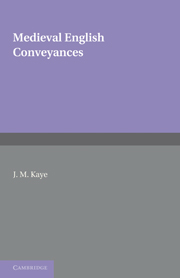Book contents
- Frontmatter
- Contents
- Preface
- Abbreviations and references
- List of year book cases
- Introduction
- 1 Common clauses in deeds
- 2 Grants in fee: general
- 3 Grants in fee: special cases
- 4 Grants in marriage, limited fee and fee tail
- 5 Grants in alms
- 6 Women's realty
- 7 Confirmations
- 8 Grants for life and for lives
- 9 Grants for terms of years
- 10 Rents
- 11 Exchanges
- 12 Surrenders and releases
- 13 Villeins and their lands
- Glossary of legal terms
- Select Bibliography
- Index
Preface
Published online by Cambridge University Press: 29 January 2010
- Frontmatter
- Contents
- Preface
- Abbreviations and references
- List of year book cases
- Introduction
- 1 Common clauses in deeds
- 2 Grants in fee: general
- 3 Grants in fee: special cases
- 4 Grants in marriage, limited fee and fee tail
- 5 Grants in alms
- 6 Women's realty
- 7 Confirmations
- 8 Grants for life and for lives
- 9 Grants for terms of years
- 10 Rents
- 11 Exchanges
- 12 Surrenders and releases
- 13 Villeins and their lands
- Glossary of legal terms
- Select Bibliography
- Index
Summary
It is more than three hundred years since a book dealing exclusively with medieval English conveyances was published. Thomas Madox's Formulare Anglicanum of 1702 contained 783 transcripts of documents ranging in date from the Anglo-Saxon period to the end of the reign of Henry VIII. Most of these documents related to the creation or transfer of estates and interests in real property, but, as the author was writing for scholarly antiquarians, not for lawyers or legal historians, his introduction did not allot much space to comment on the legal significance of the material. Madox has had no followers, for the many treatises and precedent-books of the past three centuries, written by lawyers for the use of the profession, were concerned with the law and practice current at the times of their respective publication, without any historical content. Some modern legal historians, since Maitland led the way, have made use of charter material to supplement what can be found in other sources, such as court records, feet of fines and treatises, mainly in connection with the early history of the fee simple estate, the estate tail and gifts to the church in frankalmoign, but many other transactions, important in their day, have been passed over rather lightly. The idea of writing a book which would draw attention to conveyancing transactions in general came to me when I gave a course of lectures on the subject in the University of Oxford.
- Type
- Chapter
- Information
- Medieval English Conveyances , pp. xi - xiiiPublisher: Cambridge University PressPrint publication year: 2009
- 1
- Cited by

